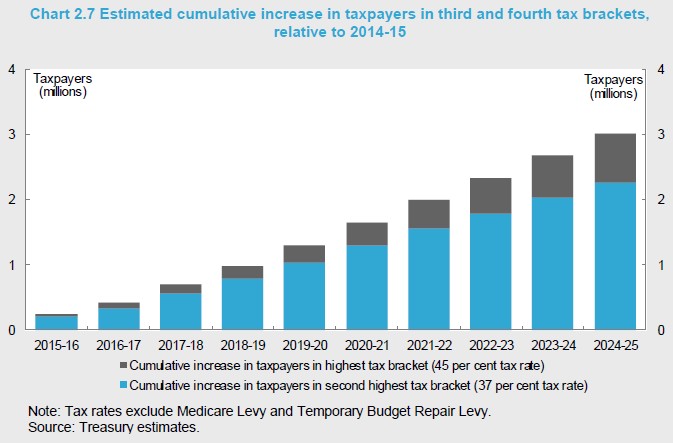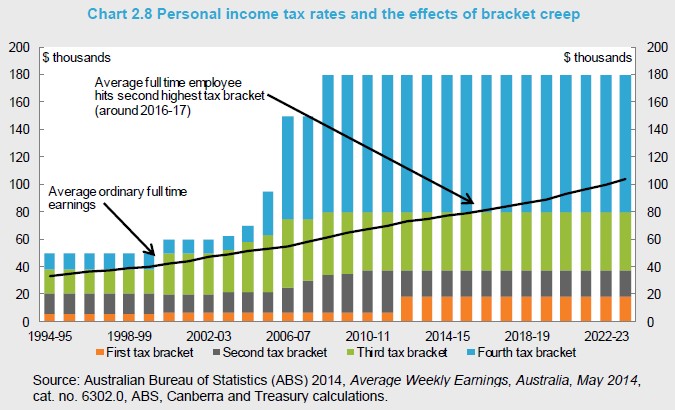Modelling by the Australian National University’s (ANU) Ben Phillips suggests that middle-income earners – those earning $1,600 in average gross income – will make the biggest contribution to reducing the Budget deficit over the period to 2020. The ANU contends this group will see their income fall by 3.8% over this period, due to a combination of increased taxation and reduced welfare payments. From The Australian:
Cuts to welfare and bracket creep will leave all households worse off by 2020 than they were in 2015, with middle-income earners suffering a fall in their incomes of almost 4 per cent… [meaning they will be] worse off than they were in 2005…
The study shows that over the five years to 2020, the government will increase its individual tax collections by $14.8 billion a year while welfare payments will be cut $5.2bn a year.
The highest 20 per cent of earners will contribute $6.3bn towards budget repair, or about 2 per cent of their income, while the next highest earning quintile will contribute $5.3bn or 2.8 per cent of their income. The biggest hit is felt by middle-income earners, which the ABS reports is households with an average gross income of about $1600 a week. They will suffer a 3.8 per cent fall in their income.
By 2020, the top-earning 20 per cent will be the only group still ahead of where they were in 2005; those in the bottom-earning 20 per cent will be back where they were; and the middle-earning 60 per cent will be worse off.
This shouldn’t be too surprising, given bracket creep (aka ‘fiscal drag’) always effects those at the lower end of the income distribution more than those at the top. As noted in the Australian Treasury’s 2015 Tax White Paper discussion paper:
Between 2014-15 and 2024-25, the percentage of taxpayers in the top two tax brackets (that is, with taxable income in excess of $80,000) is estimated to increase from around 27 per cent to 43 per cent under current policy settings. It is estimated that over 2 million more taxpayers will be in the third income tax bracket (taxable income from $80,000 to $180,000) in 2024-25, compared to 2014-15. There is also estimated to be around 750,000 more taxpayers in the fourth tax bracket (taxable income above $180,000) in 2024-25 compared to 2014-15 (Chart 2.7).
…average ordinary full-time earnings were around $75,000 in 2013-14, and are expected to be around $104,000 in 2023-24 (see Chart 2.8). Someone on average full-time earnings therefore had an average tax rate of 22.7 per cent in 2013-14, increasing to 27.4 per cent by 2023-24. By contrast, someone with only half that income earned $37,500 in 2013-14, increasing to $52,000 in 2023-24. However, their average tax rate will increase from 10.3 per cent to 17.8 per cent. Someone earning twice the average full-time wage is on $150,000, increasing to $208,000 in 2023-24, but their average tax rate will only increase from 30.5 per cent to 34.3 per cent…
While the forecasts have changed, the general theme is the same: bracket creep disproportionately impacts those lower down the income ladder.
Add the loss of welfare payments, and it is no surprise that middle-income earners will carry the load for Budget repair.



